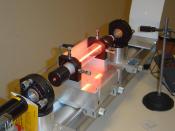Introduction:
The name LASER is an acronym for Light Amplification by the Stimulated Emission of Radiation. In 1917, Albert Einstein first theorized about the process which makes lasers possible called "Stimulated Emission." In this paper, we can view the impact of the lasers technology on society from four perspectives: the strength, the weakness, the opportunity and the threat of Lasers Applications. To sum up, we will focus on the future of Lasers on society, assessing the real value of the Lasers technology.
The strengths:
Lasers, broadly speaking, are devices that generate or amplify light, just as transistors generate and amplify electronic signals at audio, radio or microwave frequencies. Since laser light can be focused to a very small point of light, lasers are used in CD players, in surgery, in communication, in welding, in cutting, in spectroscopy and in printing industry.
Looking at the advantage of the laser, we can find that there are four characteristic of laser light.
Comparing with the other conventional technologies, one of the most frequently used characteristic of laser technology is that of coherent. That is, the emitted light waves are in phase with one another and are so nearly parallel that they can travel for long distances without spreading. Here light must be understand broadly, since lasers have covered radiation at wavelengths ranging from infrared range to ultraviolet and even soft x-ray range.
Take surgery as an example, when light is focused, the point of focus can become hot enough to burn the skin or human tissue, if the intensity of the light is great enough. This characteristic can be used to perform surgery that results in less damage than it a knife or scalpel was used.
Another example of this may be given. Focusing a very high energy laser beam on a...


